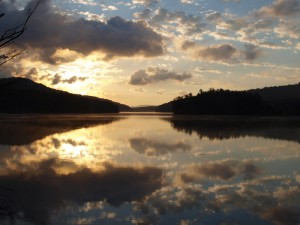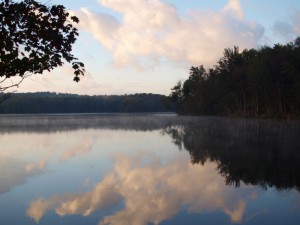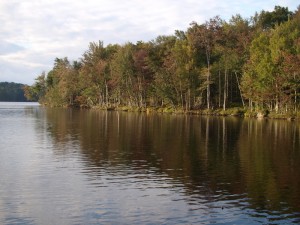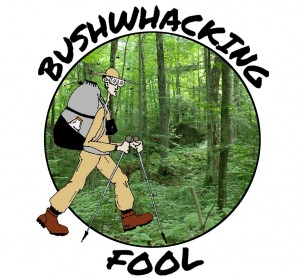
Sunrise over Moshier Reservoir
The following is the first part of a report on the fifth and final day of a bushwhacking trip through the interior of the southern portion of the Pepperbox Wilderness. The majority of the trip follows along streams and beaver vlys with the exit from the area following a marked herd path from the wild interior of this wilderness area. Highlights along the trip included the Threemile Beaver Meadow, Bear Pond, Moshier Creek and Moshier Reservoir. The first part of the fifth day consisted climbing to the height of land between Moshier Reservoir and a beaver vly east of Threemile Beaver Pond.
Date: September 4, 2010
Length: 0.69 miles (0.69 miles cumulative)
Difficulty: Moderate
The morning of the last day within the Pepperbox Wilderness was cool and wet, a direct contrast with the previous mornings on this trip. A quick look at my watch revealed I was already behind schedule; apparently I failed to turn on my alarm last night. With cold feet urging me on, I crawled out from my sleeping bag and went about greeting the day.
Packing up my tarp was especially difficult given the wet conditions. I checked my wash bowl, which I left out in the rain, to find it contained only a small amount of water. Despite the wetness of everything surrounding me, including my tarp, the tree foliage and the leaf litter, the contents of the bowl indicated there were no torrential downpours during the night. This was good news; no difficult stream crossings with raging water will be necessary.
After packing up my campsite (point #57), I retreated back to the water’s edge of Moshier Reservoir where I spent a good portion of my previous evening. The sky was partly cloudy with the rays of the rising sun setting the many scattered, dark and threatening clouds a blaze. There was no wind despite the weather reports of windy conditions during the day.
As I went about preparing my breakfast, I spotted two beavers swimming around. They appeared to be fascinated with my activities since they remained nearby but never splashed their tail on the water surface in agitation. A blue jay called in the distance, alternating between imitating a broad-winged hawk and producing its typical raucous call. Multiple red-eye vireos sang in the forest but fell quiet when a dark cloud blocked the rays of the rising sun. I heard a black-capped chickadee and white-breasted nuthatch calling, and a brown creeper singing off into the distance.
View Day five, part one in a larger map
With an oatmeal breakfast complete I packed up my remaining stuff and prepared for my final bushwhack. Just before 8 AM I set my compass for 301 degrees and disappeared into the surrounding forest heading for a large beaver vly to the northwest. This beaver meadow was located just east of the main pond in Threemile Beaver Meadow and its outlet stream fed that same pond. As I discovered on a previous trip to the area there was a marked hunter’s path located near the vly’s ancient and broken dam. This marked path was the northern terminus of the trail I entered the Pepperbox Wilderness on five days before (my blog post about this is located here ). The trail would provide an easy and speedy exit from the forest so I would have plenty of time to drive the 2+ hours home.
The bushwhack started out easy enough with a gradual increase in elevation through a largely hardwood forest. Red maple , yellow birch and American beech dominated the forest here. The clusters of spruces in the understory seemed to be strategically scattered about to ensure my passing through them so as to get soaked in their rain drenched foliage. Other than the scattered conifers, the understory consisted mostly of young American beech trees although for the first time on the trip I noticed some scattered striped maples too. At one point I stopped and marveled at an exceptionally large yellow birch tree.

Moshier Reservoir
After stopping to fertilize the forest floor, I attempted to mark a waypoint using my handheld GPS. Despite having the most recent technology (I bought this GPS earlier in the year to replace an older one on the fritz) the wet foliage foiled the accuracy of the GPS as it placed me somewhere I knew I was not. Upon locating a gap in the canopy I finally obtained an accurate location via the GPS and much to my relief I was indeed where I needed to be (point #58).
As I continued to slosh through the wet vegetation as I approached the height of land my legs below the knees became increasingly saturated. The years of bushwhacking apparently took a toll on my Golite Reed rainpants and they were now leaking. This was extremely upsetting to me as these proved to be the lightest, toughest and most rainproof of any rainpants I have ever owned. Since this model of rainpants was no longer being manufactured I would have to start any replacement search from scratch. The thought of this search and the hours of frustration navigating through the world of backpacking rain gear with its near-infinite choices of materials weighed heavily on my mind along this portion of the bushwhack.

Moshier Reservoir
In addition to the wet legs I found taking notes more difficult due to the wet conditions. My choice of a small compositional notepad (4.5 x 3.25 inches) that I purchased years ago at Staples proved to be less than adequate under the present conditions. And since it was hard to write on wet paper (thankfully I was using a pencil since pen is even more difficult to use in wet conditions) I kept less than adequate notes of this section of my trip, relying on my memory 4-months after the fact. In the future, I planned on obtaining some ”Rite in the Rain” memo books for my trips during the next season’s trips.
As the terrain leveled off I knew I was coming to the highest point of my bushwhack (point #60) and from here on it was all downhill to the beaver vly.




